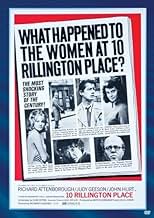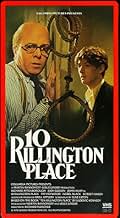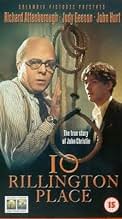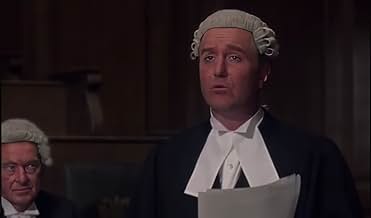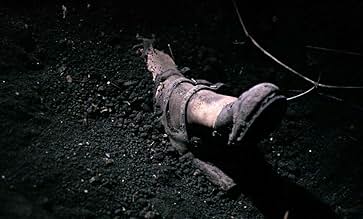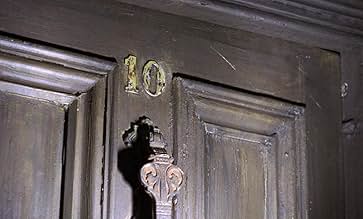VALUTAZIONE IMDb
7,5/10
10.552
LA TUA VALUTAZIONE
Cosa è successo alle donne al 10 di Rillington Place?Cosa è successo alle donne al 10 di Rillington Place?Cosa è successo alle donne al 10 di Rillington Place?
- Regia
- Sceneggiatura
- Star
- Nominato ai 1 BAFTA Award
- 1 candidatura in totale
André Morell
- Judge Lewis
- (as Andre Morell)
Recensioni in evidenza
Three years after "the Boston strangler" ,Richard Fleischer brilliantly succeeds in transferring to the screen a horrible true story.The two movies do not look like each other though."Boston strangler" was spectacular,making the best use of the split screen I've ever seen."10 RP" is an austere bleak work ,all the more disturbing than its style is bald.Richard Attenborough(an extraordinary performance,on a par with Peter Lorre's"M") portrays one of those serial killers in the first half of last century.Two good examples :Landru ,whose character Charlie Chaplin used in "Monsieur Verdoux " and Claude Chabrol in his eponymous movie,or "Doctor Petiot" who was doing on a small scale (killing Jews to despoil them) what the Nazis were doing on a large one. Christie ,Landru and Petiot are close relatives.They seem harmless,mediocre little men .Not the serial killer we meet in today's thrillers.And Christie is given the adequate treatment by his director:the poor house,the crummy flats ,the pubs ,the no-future of an uneducated generation (Fleischer lays stress on the fact that Tim cannot read and write ).This illiteracy is partly responsible for Tim's unfair revolting fate.
Fleischer's style is plain;the trial scenes,when any director would have his actors overact is a lesson a lot of the current artists should pay attention to.The hanging could not be spookier.One cannot help but think that the last lines about Tim on the screen are a bit ironical.
Matching Attenborough's awesome portrayal,is John Hurt's remarkable Tim:definitely not Gregory Peck as his wife thinks,macho but pitiful,a not very handsome whining lad who cannot hold a candle to his maleficent owner.
You should see "the Boston strangler" and "10 Rillington place" one after the other
Fleischer's style is plain;the trial scenes,when any director would have his actors overact is a lesson a lot of the current artists should pay attention to.The hanging could not be spookier.One cannot help but think that the last lines about Tim on the screen are a bit ironical.
Matching Attenborough's awesome portrayal,is John Hurt's remarkable Tim:definitely not Gregory Peck as his wife thinks,macho but pitiful,a not very handsome whining lad who cannot hold a candle to his maleficent owner.
You should see "the Boston strangler" and "10 Rillington place" one after the other
10drj-12
10 Rillington Place is more than a classic film. It is frequently referred to whenever the call for the death penalty is made in Britain. The notorious miscarriage of justice i.e the hanging of Timothy Evans, an immature half-wit, for the murder of his wife and child when it is almost universally accepted that they perished at the hands of John "Reg" Christie, is one which will always haunt the British legal system. When Christie was found guilty and hanged as a serial killer of women, the body of Evans was exhumed and reburied in consecrated ground but this did nothing to hide the embarrassment of those who supported the death penalty.
The film itself is a dark and brooding masterpiece which depicts life in post-war London perfectly. The grim, dirty, rain-washed Rillington Place in Notting Hill was a seedy side-street which housed the poor but largely respectable families which had survived the blitz. John Christie had moved down from the North to find work in the capital but ill-health and a penchant for petty crime prevented him from being successful.
Richard Attenborough plays the downtrodden but curiously arrogant Christie to perfection. His voice almost a whisper as he lauds it over London's underclasses. In fact Christie was not a landlord, as many believe, he was merely a tenant who fancied himself to be a landlord and acted accordingly. He also dreamed of being a doctor, with devastating consequences. His treatment of the poor, subnormal Evans (John Hurt) and his beautiful but foolish young wife, Beryl, (Judy Geeson) was centred around their desire for an abortion - illegal in the UK until the late 1960s.
John Hurt is very good as the hapless Evans although his Welsh accent needed refining. His look of wide eyed horror and disbelief is a sight to behold. Geeson pouts and whinges and looks gorgeous: the kind of wife any man would desire and yet the kind destined to irritate intensely.
The key to appreciating 10 Rillington Place is to have some idea of its setting in British history. To wander in clueless will result in disappointment. There is no gore or x-rated content of any kind and its slow pace will infuriate many. Yet, as a snapshot of an England now gone and a reminder of the folly of capital punishment it is a timeless classic worthy of many viewings.
The film itself is a dark and brooding masterpiece which depicts life in post-war London perfectly. The grim, dirty, rain-washed Rillington Place in Notting Hill was a seedy side-street which housed the poor but largely respectable families which had survived the blitz. John Christie had moved down from the North to find work in the capital but ill-health and a penchant for petty crime prevented him from being successful.
Richard Attenborough plays the downtrodden but curiously arrogant Christie to perfection. His voice almost a whisper as he lauds it over London's underclasses. In fact Christie was not a landlord, as many believe, he was merely a tenant who fancied himself to be a landlord and acted accordingly. He also dreamed of being a doctor, with devastating consequences. His treatment of the poor, subnormal Evans (John Hurt) and his beautiful but foolish young wife, Beryl, (Judy Geeson) was centred around their desire for an abortion - illegal in the UK until the late 1960s.
John Hurt is very good as the hapless Evans although his Welsh accent needed refining. His look of wide eyed horror and disbelief is a sight to behold. Geeson pouts and whinges and looks gorgeous: the kind of wife any man would desire and yet the kind destined to irritate intensely.
The key to appreciating 10 Rillington Place is to have some idea of its setting in British history. To wander in clueless will result in disappointment. There is no gore or x-rated content of any kind and its slow pace will infuriate many. Yet, as a snapshot of an England now gone and a reminder of the folly of capital punishment it is a timeless classic worthy of many viewings.
There's a whole host of films from the great decade that was the seventies that have gone on to not get the praise that they so rightly deserve, and if one were to make a list of those films; 10 Rillington Place would feature in a prominent position. The film follows the true story of serial killer John Christie, who murdered a series of women in the late forties. His modus operandi is to murder his victims with gas, shortly before having sex with the corpse. Despite this shocking premise, the film always sees fit to focus more on the reality of the situation than the actual murders themselves. Despite not being graphic, this actually makes the film more shocking as we are constantly reminded of the things that go on behind what people allow us to know about ourselves. The murderer in this story is just a normal man. A nice man, in fact. People trust him, and even respect him; yet despite all this, the man is a stone cold killer. The realistic way that the story is approached, combined with the fact that these are real events ensures that 10 Rillington Place is a morbidly fascinating watch.
Richard Attenborough takes the lead role and does fantastically well with it. His calm mannerisms and nonthreatening demeanour clash well with the underlying evil of his character and we really can believe that this man is a maniac. The film was made in the United Kingdom, I'm proud to say, and this is obvious throughout. UK films have a certain atmosphere about them, and although I didn't know that this movie was homegrown before watching it; it soon became apparent. This style bodes well with the theme of the film, as it's downtrodden and makes sure that the film is firmly planted in the land in which the story took place. The idea of an innocent man not only going down, but being killed, for a crime he did not commit is shocking and the cold way that it is presented in this film reflects the fact that it actually happened and also gives it more of a degree of shock. On the whole, 10 Rillington Place is a film that shouldn't be missed by anyone. It's not all that well known, but this is unfair considering the quality of it and I wont hesitate to recommend this movie to people in the future.
Richard Attenborough takes the lead role and does fantastically well with it. His calm mannerisms and nonthreatening demeanour clash well with the underlying evil of his character and we really can believe that this man is a maniac. The film was made in the United Kingdom, I'm proud to say, and this is obvious throughout. UK films have a certain atmosphere about them, and although I didn't know that this movie was homegrown before watching it; it soon became apparent. This style bodes well with the theme of the film, as it's downtrodden and makes sure that the film is firmly planted in the land in which the story took place. The idea of an innocent man not only going down, but being killed, for a crime he did not commit is shocking and the cold way that it is presented in this film reflects the fact that it actually happened and also gives it more of a degree of shock. On the whole, 10 Rillington Place is a film that shouldn't be missed by anyone. It's not all that well known, but this is unfair considering the quality of it and I wont hesitate to recommend this movie to people in the future.
I saw this in a theatre here in the United States in 1971, when I was eleven years old. I'd seen Richard Attenborough as the circus master in DOCTOR DOLITTLE and I wonder if I'd sold my mother on taking me to this one because I knew the name Richard Attenborough. In any case, this movie burned itself into my brain immediately and, for the next three decades I told many of my fellow American film-buffs that there was this British movie no American had ever heard about that was more blood-curdling than PSYCHO. I suspect the obviously limited release of this movie in the United States had something to do with the fact that one of its chief selling-points was that it was based on a murder not well-known to Americans. The Christie murders were famous in Britain, and, in fact, historic because of their effect on the elimination of the UK's death penalty. But the distributors in America had to market this on its qualities as a thriller. Attenborough had yet to make his name a household word here, GHANDI being about ten years in the future and the probable difficulty with accents couldn't have made people who did see it very eager to recommend it. On top of this, the movie is not a thriller but a truly disturbing exploration of evil. It makes the roughly contemporary FRENZY look like a sitcom. Movies became more realistic in the late sixties and early seventies than they have been before or since. 10 RILLINGTON PLACE may be the most realistic movie about a serial killer ever made. It may not be the scariest, but it's the most memorable. I haven't forgotten it, and I haven't seen it in more than a generation. It is a mournful movie for serious viewing.
No need to repeat consensus points already made. Instead, I'll try to touch on noteworthy aspects generally unmentioned.
The movie's not only a reflection on the death penalty, but on anti-abortion laws, as well. Those desperate women wouldn't have been driven into the clutches of the lunatic Cristie were abortion licensed and legal. That may not have stopped his madness, but he would have had to come up with a different ploy.
The movie focuses on one particular episode (the Evans killings) rather than the series of killings that actually covered a considerable time period. So, cooped up in the city, Cristie ends up hiding his many victims where he can (in the garden, in the washroom, in the walls). What surprises me is that no one, least of all, the wife, notices what must have been an atrocious smell.
Note the dispatch with which Evans is hanged, unlike the more ritualized American way. I assume the movie is an accurate depiction. He walks into an ordinary room, the hood is placed over his head, and plop, the trapdoor opens. And it takes just about that long. The suddenness really startled me.
Contrast two ends of the serial killer spectrum—the shy, unattractive Cristie and the charming, handsome Ted Bundy of 1970's America. Understandably, Bundy had no trouble luring girls to their doom; judging from the movie, however, Cristie's victims must have been truly desperate to let that little creep lay hands on them.
Not mentioned in the movie, but in one of the books that I recall, is that Cristie kept swatches of pubic hair as trophies.
Like any good document on serial killers, the film presents a glimpse of lives and social levels that otherwise go unnoticed. Here we get a sense of a decaying part of London and the dreary lives hanging on there. A good movie or book is like a knife slicing through a cake, exposing layers that otherwise remain hidden. That's the particular strength of this film.
My only reservation is the casting of Judy Geeson as Evans' wife. She seems too pretty and smart to be hooked up with a dead-ender like Evans. Still and all, Geeson's performance is excellent— note her subtle expressions on first meeting the creepy Cristie. Nonetheless, I suspect her casting was the one concession the producers made to commercial appeal.
All in all, it's a grim, ugly film-- as it should be. We may not get much sense of why Cristie has taken the warped, monstrous turn he has. But then such dark matters may be beyond us, anyway. Above all, the movie should not be viewed in a depressed state or if you're looking for a room to rent.
The movie's not only a reflection on the death penalty, but on anti-abortion laws, as well. Those desperate women wouldn't have been driven into the clutches of the lunatic Cristie were abortion licensed and legal. That may not have stopped his madness, but he would have had to come up with a different ploy.
The movie focuses on one particular episode (the Evans killings) rather than the series of killings that actually covered a considerable time period. So, cooped up in the city, Cristie ends up hiding his many victims where he can (in the garden, in the washroom, in the walls). What surprises me is that no one, least of all, the wife, notices what must have been an atrocious smell.
Note the dispatch with which Evans is hanged, unlike the more ritualized American way. I assume the movie is an accurate depiction. He walks into an ordinary room, the hood is placed over his head, and plop, the trapdoor opens. And it takes just about that long. The suddenness really startled me.
Contrast two ends of the serial killer spectrum—the shy, unattractive Cristie and the charming, handsome Ted Bundy of 1970's America. Understandably, Bundy had no trouble luring girls to their doom; judging from the movie, however, Cristie's victims must have been truly desperate to let that little creep lay hands on them.
Not mentioned in the movie, but in one of the books that I recall, is that Cristie kept swatches of pubic hair as trophies.
Like any good document on serial killers, the film presents a glimpse of lives and social levels that otherwise go unnoticed. Here we get a sense of a decaying part of London and the dreary lives hanging on there. A good movie or book is like a knife slicing through a cake, exposing layers that otherwise remain hidden. That's the particular strength of this film.
My only reservation is the casting of Judy Geeson as Evans' wife. She seems too pretty and smart to be hooked up with a dead-ender like Evans. Still and all, Geeson's performance is excellent— note her subtle expressions on first meeting the creepy Cristie. Nonetheless, I suspect her casting was the one concession the producers made to commercial appeal.
All in all, it's a grim, ugly film-- as it should be. We may not get much sense of why Cristie has taken the warped, monstrous turn he has. But then such dark matters may be beyond us, anyway. Above all, the movie should not be viewed in a depressed state or if you're looking for a room to rent.
Lo sapevi?
- QuizRichard Attenborough's make-up, mainly consisting of a bald pate, took three hours to apply every morning.
- BlooperWhen Christie is explaining the procedure he's about to perform on Beryl, he says that natural gas contains carbon monoxide, then quotes its formula as CO2 (which is actually carbon dioxide). The correct formula for carbon monoxide is CO. However, the point appears to be to show him for the half-educated conman he is. It's just Christie's character creating an air of "expertise".
- Citazioni
John Reginald Christie: It's the moral question that concerns me, the taking of life - no matter how rudimentary.
Beryl Evans: It's not really... I'd be ever so grateful, Mr Christie.
- Curiosità sui creditiPrologue to opening credits: "This is a true story. Whenever possible, the dialogue has been based on official documents"
- ConnessioniFeatured in Interview with Sir Richard Attenborough (2004)
I più visti
Accedi per valutare e creare un elenco di titoli salvati per ottenere consigli personalizzati
- How long is 10 Rillington Place?Powered by Alexa
Dettagli
- Data di uscita
- Paese di origine
- Lingua
- Celebre anche come
- 10 Rillington Place
- Luoghi delle riprese
- 10 Rillington Place, Notting Hill, Londra, Inghilterra, Regno Unito(location exteriors, still occupied during filming - demolished 1970)
- Aziende produttrici
- Vedi altri crediti dell’azienda su IMDbPro
Contribuisci a questa pagina
Suggerisci una modifica o aggiungi i contenuti mancanti

Divario superiore
By what name was L'assassino di Rillington Place n. 10 (1971) officially released in India in English?
Rispondi

